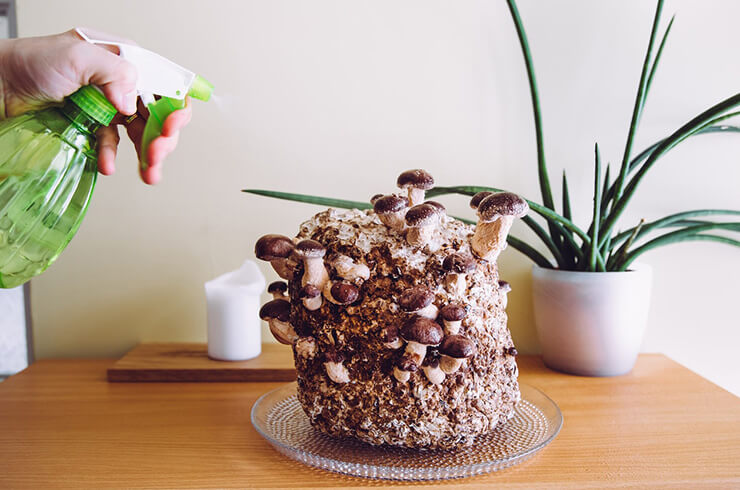Mushrooms are a fascinating and flavorful addition to any indoor gardening setup. Unlike most edible crops, they don’t require sunlight to grow—making them a perfect choice for homes with limited natural light. They’re grown from spores, not seeds, and thrive in damp, cool environments. With the right materials and a bit of care, you can cultivate your own harvest of gourmet mushrooms right on a shelf, in a cabinet, or even under the sink.
Mushrooms grow in the dark, feed on byproducts like sawdust or coffee grounds, and turn humble materials into culinary gold. Whether you’re aiming for savory shiitakes or delicate oyster mushrooms, growing fungi indoors is surprisingly simple and rewarding. Plus, mushrooms offer both culinary and nutritional value, with many varieties rich in protein, fiber, antioxidants, and umami flavor. Many gourmet mushrooms are hard to find fresh in stores—making home cultivation especially satisfying.
With the right setup—humidity, cleanliness, and airflow—you can cultivate mushrooms all year long. They’re low-light friendly, space-efficient, and a delicious way to expand your gardening repertoire indoors.

Growing Medium and pH Preferences
Mushrooms don’t grow in traditional garden soil. Instead, they require a specific growing medium called a substrate—the material that supports fungal growth.
- Common Substrates:Straw, hardwood sawdust, coffee grounds, coconut coir, and composted manure are all commonly used.
- pH Range:Most edible mushrooms prefer a slightly acidic environment, around 5 to 6.5.
- Sterility:Cleanliness is key. Start with sterilized or pasteurized substrates to prevent contamination by mold or unwanted fungi.
Light Requirements
One of the great advantages of mushroom growing is that most mushrooms do not need light to grow—at least not in the same way as plants.
- Germination:During the spawn run (mycelium colonization), mushrooms grow best in total darkness.
- Fruiting Stage:Once fruiting begins, low indirect light helps guide mushroom development. A simple ambient light source is usually enough.
- Tip:Avoid direct sunlight, which can dry out your substrate and affect humidity levels.
Watering and Humidity Needs
Moisture is absolutely essential for successful mushroom cultivation. Unlike plants, mushrooms absorb water from the air and their environment, not through roots.
- Humidity:Maintain a relative humidity of 80-95% during fruiting.
- Misting:Mist the growing area lightly 1-2 times daily or use a humidity tent or dome to maintain moisture.
- Airflow:Mushrooms need fresh air exchange to prevent carbon dioxide buildup. Avoid sealed containers and ensure gentle air movement without drying out the environment.
Ideal Indoor Growing Conditions
Mushrooms are cool-weather crops, which makes them well-suited for indoor environments like basements, closets, and shaded corners.
- Temperature:Most common varieties fruit best between 55-70°F (13-21°C).
- Containers:Plastic tubs, bags, or buckets can all work as growing vessels. Just make sure they’re clean and provide some ventilation.
- Lighting:A low-wattage lamp or indirect window light is usually sufficient.
- Cleanliness:Sanitize tools and growing areas before and during the growing process to prevent unwanted mold or bacteria.
Mushroom Variety Guide: 5 Fantastic Indoor Options
Mushrooms are having a moment. Whether you’re drawn to their rich, meaty textures or intrigued by their quirky growing habits, mushrooms offer a unique gardening experience. They’re low-maintenance, take up little space, and can be grown vertically or in tucked-away spaces other crops can’t use. Many gourmet mushrooms are hard to find fresh in stores—making home cultivation especially satisfying.
Below are five varieties perfect for indoor gardening—each with its own flavor profile, growing quirks, and kitchen uses.
Oyster Mushrooms
These fan-shaped mushrooms are some of the easiest to grow at home. They come in a range of colors (gray, pink, blue, and yellow) and grow quickly on many substrates.
Indoor Perks:
- Fast growth—fruiting in as little as two weeks
- Adaptable to straw, coffee grounds, or sawdust
- Ideal for beginners and kids
Culinary Uses:
- Sautéed in butter or olive oil for pasta or rice dishes
- Torn into soups or stews for a meaty texture
- Crisped up as a bacon substitute
Shiitake
Prized for its deep, umami flavor, shiitake is commonly grown on hardwood logs or sawdust blocks. It’s slightly slower to grow than oyster mushrooms but well worth the wait.
Indoor Perks:
- Long-lasting flushes from a single block
- Grows well in indoor humidity tents or grow bags
- Excellent shelf life when harvested
Culinary Uses:
- Sliced into stir-fries or noodle dishes
- Roasted or grilled with soy and sesame
- Added to broths or ramen for depth
Lion’s Mane
This unique, white, shaggy mushroom gets its name from its appearance. A large growth can resemble a waterfall. Known for its seafood-like texture, it’s also being studied for brain and nerve health.
Indoor Perks:
- High humidity needs but otherwise easy to grow
- Grows in hanging bags or tubs
- Distinctive appearance makes it fun to observe
Culinary Uses:
- Sliced and pan-fried as a crab or lobster substitute
- Used in vegetarian steaks or cutlets
- Served with garlic and butter on toast
Enoki
Enoki mushrooms form long, slender white stems with tiny caps. They thrive in cooler temperatures and grow in tight clusters, often in jars or bottles.
Indoor Perks:
- Requires minimal space and can grow in jars
- Grows well in cooler rooms (50-60°F)
- Delicate and elegant appearance
Culinary Uses:
- Added raw to salads and cold noodle dishes
- Simmered in miso soup or hot pot
- Used as garnish for sushi or rice bowls
King Oyster
The largest of the oyster mushroom family, King Oysters grow thick stems and small caps. They’re prized for their firm, meat-like texture.
Indoor Perks:
- Slow-growing but yields large, hearty mushrooms
- Grows best in vertical bags or bottles
- Excellent in dry climates with some humidity support
Culinary Uses:
- Sliced into medallions and grilled
- Braised or seared like scallops
- Used in vegan meat alternatives


 Previous
Previous

